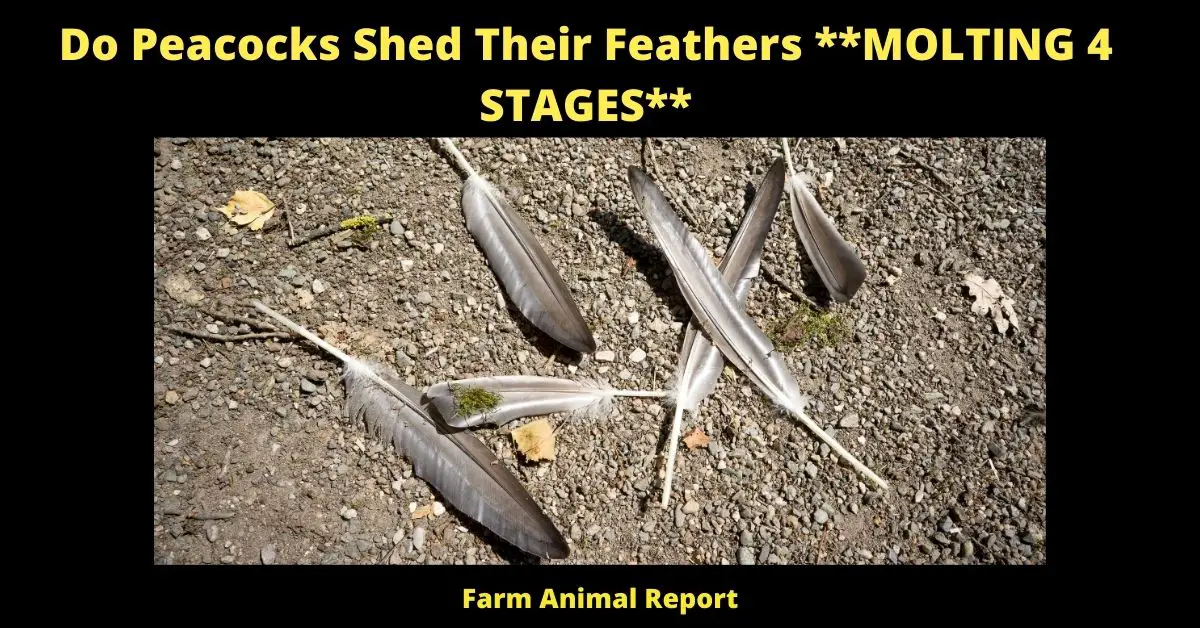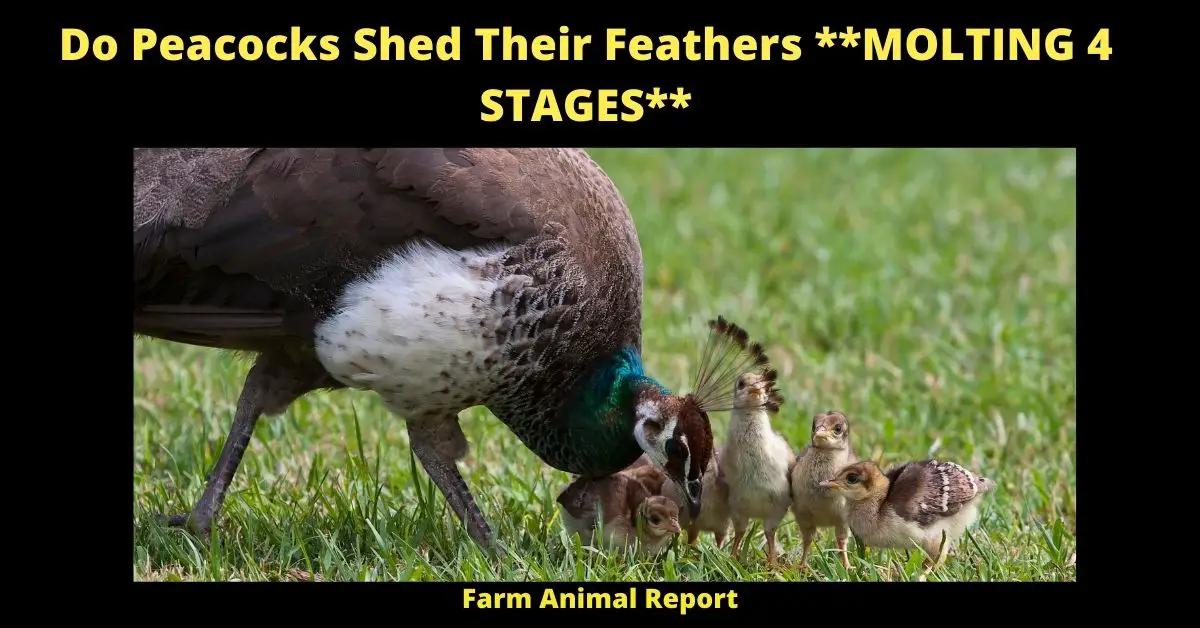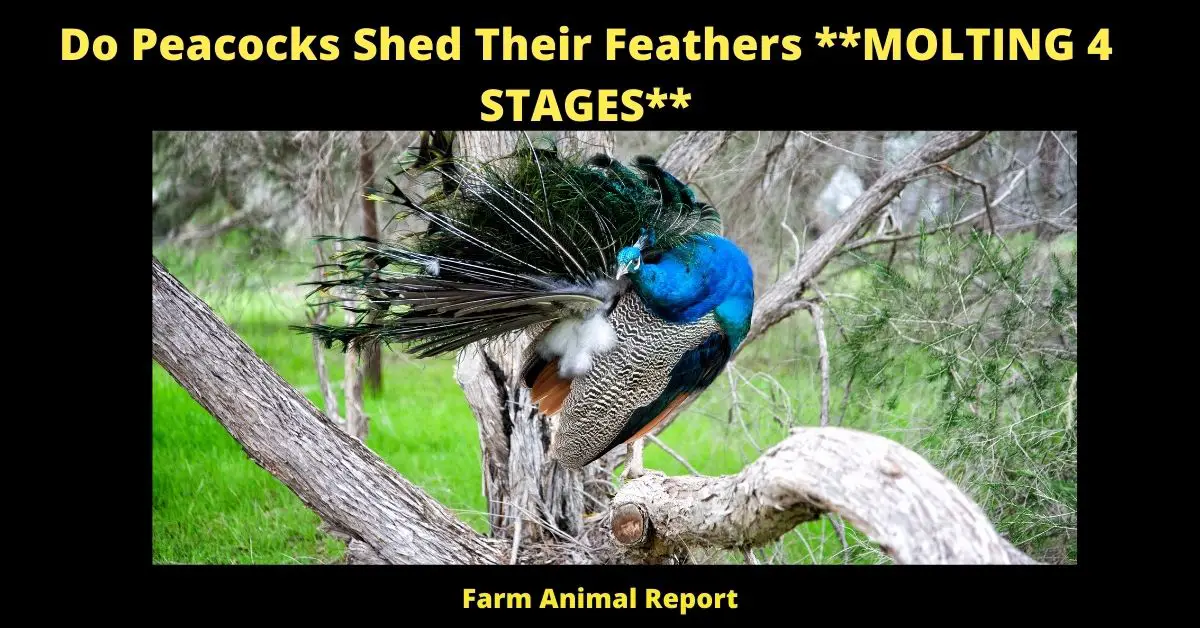Do peacocks shed their feathers? Yes, they do. Peacocks are classified as a “pea” or peafowl species and can be found in India all the way to Africa. They have an array of colors that range from blue to green, red, brown, and white.
Male peacock feathers are called ‘tail’ feathers while female peacock’s tail is called a train of feathers. The male has one train of long plumage that spans 18-27 inches (46-69 centimeters) which are used for courtship displays during mating season.
When it comes time for breeding season, males will show off their beautiful trains in order to attract females with whom they will mate regularly during this time period only! Do Peacocks Shed Their Feathers?
Do Peacocks Shed Their Feathers?
As a general rule adult peacocks will molt, and gradually lose their feathers each year. This allows for new feathers to replace old worn-out ones. There are 4 Stages to a peacock’s molting process. Peacocks can also lose their feathers because of Illness, poor diet, and fighting.
Peacock Shedding Facts – Peacock Feathers
Do Peacocks lose Their Feathers – Adult Peacocks naturally molt their feathers once a year.
During this time, Peacocks lose anywhere from 25-75% of their entire plumage.
While molting is normal for adult peafowls to do by itself, it could also be caused due to stress or health issues that the bird might have recently experienced which can cause them not to be able to replace their feathers.
If You would Like to add to Your Peacock Raising Library Check Out These Great Books on Amazon
Peacocks need an ample amount of rest and full nutrition while they are molting so that they can produce new, healthy feathers in a timely manner.
When Peafowls lose all of their older primaries (the longer wing feathers), it is when the bird will not fly for several weeks or months.
While Peacocks can lose several feathers at once, this is normal and should not be cause for alarm as long the bird has enough healthy additional primary wing feathers to fly.
A peacock’s tail coverts (the smaller feather surrounding the tail) will also fall out when molting but these are replaced within a few weeks or so.
If you do happen to see a peacock with bald spots, it is likely due to health issues and you should contact a veterinarian immediately.

How many Feathers Does a Peacock Have? Peacock Tail Feathers
A peacock has several types of feathers they are:
- The head feathers: They are small and round.
- The neck feathers: They are long and thin.
- The breast feathers: They are large and fan out.
- The back feathers: They are short and lie close to the body.
- The tail feathers: The most noticeable, these are very large and colored.
- The downy feathers: They are small, soft, fluffy feathers that cover the bird’s body underneath their other feather types.
- Peacocks have totally about 200 feathers. Feathers are important for birds because they help keep them warm, and also provide camouflage.
- When a peacock molts or sheds its feathers, it will lose all of its head feathers, most of its neck feathers, and some of its breast feathers. The tail feathers will usually stay in good condition, but sometimes a few will fall out. New feathers will grow in to replace the old ones.
- Molting is a natural process that all birds do, and it’s important for their health. Feathers wear out over time, and moltings allow birds to get rid of old feathers and grow new ones. It usually happens once a year, but can vary depending on the bird’s environment and lifestyle.
- Peacocks usually molt once a year, but the timing can vary depending on the bird’s environment and lifestyle. New feathers will grow in to replace the old ones.
Peacock Molting Process – 4 Stages – Peafowl
Peacock molting is natural and healthy the stages of Peacock molting yearly are
- Stage one: growth of new feathers beginning mid-August. This stage can last up to six weeks and the Peacock will have a very ragged appearance. The tail will be particularly affected during this time which is why it has been dubbed ‘Picking’ in some areas. There may be no other outward signs of the molting process as it occurs.
- Stage two: the Peacock will continue to lose some feathers at this stage, but not many so there is no need for alarm. The tail during this time may look particularly ragged which can be caused by a few loose feathers being picked out by other birds still.
- Stage three: the Peacock will enter stage three in mid-October and this is when the molting process begins to speed up. The feather loss at this time can be quite noticeable, but there are still no signs of any bare patches on the body. By now, however, it would probably be wise for owners to keep a closer eye on their pets as they may be more sensitive to conditions at this time.
- Stage four: this is the final stage of molting and it will begin around mid-November. The entire feathering cycle can take up to six weeks, but by now, most Peacocks should look extremely shiny and healthy. There will be no bare patches at all and their feathers should not only look shiny but also feel silky smooth to the touch.
How Often do Peacocks Molt?
Peacocks molt once a year, in the late summer or early fall.
During the molt, peacocks lose all of their old feathers and grow new ones. The new feathers are much larger than the old feathers, and they make the peacock look very colorful.
Jump to 10 Ways to Make **MONEY** Peacock Farming
Baby Peacock Feather Growth stages are
- From the time a baby peacock is born, its feathers grow in a specific way and order. Baby peacocks start out with just a few small downy feathers on their heads. These tiny feathers are replaced by new feathers as the baby peacock grows older. The juvenile plumage of a baby peacock is mostly brown or tan, which helps them camouflage in the grass to avoid predators. Their tails are also covered with downy feathers and they do not look like an adult peacock or peahen yet.
- The first kind of adult feather that a baby peacock grows is called its juvenile plumage, this stage can last anywhere from six months to three years. When a peacock is in its juvenile plumage, it looks almost like a normal peahen and the only difference between them would be its eyes. Baby peacocks do not have blue skin around their eyes until they become adults because when they were babies, the feathers covered up their eye area.
- Another kind of feather that baby peacocks grow is called the nuptial feathers, these are normally bright and colorful to attract a mate. These peacock tail feathers can start growing when they reach 18 months old or about one year after their juvenile plumage starts sprouting. The baby peacocks’ tails do not fully blossom into an adult’s train until they are around four years of age, sometimes they do not get their full train until they are six years old.
- During the process of growing their nuptial feathers, baby peacocks will lose some of their juvenile plumage. This is completely normal and a part of their growth process. Most babies will only lose about 20% of their juvenile feathers, but in some cases, they can lose up to 50%. When peacocks lose their juvenile feathers, they will be replaced by bright and colorful nuptial adult tail feathers.
- The final kind of feather that a baby peacock grows is called an adult train or display plumage, these are the most beautiful and showy type of all peacock tail feathers. Around two years of age, baby peacocks will start growing their adult train and it can last anywhere from two to five years. During this time period, the color of a baby peahens eyes changes as well as her overall look.
- Baby peacocks grow all three types of feathers during different growth periods, but those are not the only kinds that they can have. Peacocks can also grow secondary and tertiary feathers. Those specific kinds of peacock tail feathers are rarely seen by humans, but they help the bird fly and protect their wings from damage so those types of peacock feather growth is very important as well.
- Peacocks have a total lifespan of about twenty years in captivity or in the wild, and during that time they will go through many different feather growth stages. So the next time you see a baby peacock or even an adult peacock, take a closer look at their feathers and appreciate their beauty!
When do Peacocks Spread their Feathers?
Peacocks will spread their tail feathers when
- Mating Dance
- When a peacock sees a potential mate, he will start to dance. He will lift his feathers up and shake them around to show off his beautiful colors. If the female is interested, she will walk over to him and they will mate.
- Peacocks can also spread their feathers when they are angry or scared. They will puff out their feathers to make themselves look bigger and more intimidating. This can help protect them from danger.
- Predators
- Scared
- Stretching
- Bathing
How to tell if a Peacock is Sick or Molting?
Peacocks are beautiful creatures and it can be difficult to tell when they are not feeling well. Here are a few tips on how to tell if your peacock is sick or molting:
- If your peacock is lethargic and not eating, he may be sick. Look for other signs of illness such as discharge from the nostril, eyes, or ear.
- Bald spots may also be a sign of illness.
- Red irritated skin may also be due to illness.
- Stops Eating – a peacock that has stopped eating for more than 24 hours is likely sick.
- Parasites can cause your peacock to appear molting. To treat this parasite, you can use a poultry tonic or an anti-parasite medication that is approved for birds.
- If you are not sure whether your peacock is sick or molting, it is
- Peafowls often lose their feathers during the molting season in late autumn and throughout winter. Feather loss is normal for peafowl but if they are shedding more than usual it may be a sign that something is wrong with them health-wise. Remember to always ask your vet before trying any home remedies.

Final Thoughts – do peacocks shed their feathers
In Summary:
– Peacocks go through many different feather growth stages throughout their lifespan.
– Baby peacocks grow juvenile feathers, then adult train feathers, and finally secondary and tertiary feathers.
– There are three types of peacock tail feathers: juvenile, nuptial, and adult train.
– A baby’s eyes and overall look change as they grow their adult train.
– When do peacocks spread their feathers? Peacocks will spread their tail feathers when mating, scared, or to protect themselves from predators.
– A lethargic and sick peafowl may have other signs of illness such as discharge from the nose, eyes, or ears





